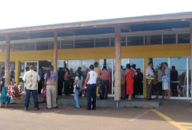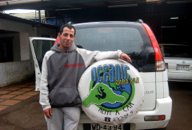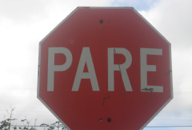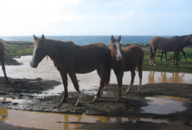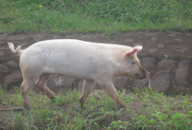Travel on easter island
Rapa Nui, isla de pascua, chile
the pacific ocean
June 12-15, 2008


Travel on easter island
Rapa Nui, isla de pascua, chile
the pacific ocean
June 12-15, 2008




Flying from Papeete, Tahiti to “Isle de Pacques” (French name, upon boarding) we arrived at 9 AM on Easter Island (Isla de Pascua, Spanish name upon arrival). The airport is Rapa Nui Airport (the island’s original name), on the southwestern tip of Easter Island, near the one and only town of Hang Roa. Once through immigration, we collected our baggage, put them through a scanner, as instructed, then exited the building. A collection of rather motley “meet and greet personnel”, fake flower leis in hand, were there to greet the arrivals who were signed up for tours. Since Henry and I were thankfully “on our own”, one of the nice tour women hailed us a taxi. A little red (and very dirty) compact car drove up to the curb, taxi sign on its roof. We all helped loading our bags in the trunk, and we were off. This $4.00 ride took us to our hotel, just a five minute ride away. We began our journey on a paved highway, then quickly turned onto a dirt road with a “lake” of water, deep, ruts, and rocks strewn strewn about, just to make the ride extra bumpy. We arrived at our “hotel”, the best on the island, from what I can judge. I turned to Henry and jokingly remarked “look, it’s an Aman ... they’ve an open air reception hall!” The Hotel Hanga Roa turned out to be a nice place with really sweet people. The standard here is pretty basic; however, the room decor was just fine. Our room, one of three in a dozen corrugated roofed and sprayed concrete walled “bungalows, was furnished with wicker furniture, tiled floors, and a ceiling fan. We had a secured sliding glass door onto a covered patio with views of the ocean and, just off our periphery, an official blue-roofed radar station of the Chilean Armada. The best part of this location was its proximity to town, with convenient access to the bank, the minimart, and restaurants, although we had breakfast and dinner at the hotel’s restaurant daily. Once settled in, by 10 AM, we requested the desk clerk to order us a rental car, indicating from a choice of photos, that we wanted a small four wheel drive vehicle delivered to the hotel at noon. It arrived, very punctually, with a nice, and very funny employee of Rapa Nui Rent A Car. The car was clean on the outside, but had seen a few miles on the inside. When we inspected for dents before signing off, every bumper had a scrape! We had no idea what to anticipate, so I took the time to read the “Articulos/Articles” of the contract. I almost started laughing, because the translation into English was hilarious. For example, (English translation, this is written verbatim): “The client asume (sic) the whole responsability (sic) for hurt caused of vehicle or other species give in the rental.” and the next clause, “The client asume (sic) the responsability (sic) for hurt and accident caused to third from hour of exit the vehicle.” Before we bolted for the door, our agent introduced us to “Rosita”, the owner of the company, who explained that the “other species” mentioned in the contract referred to horses or cows, which were often on the roads. We assured her that we have plenty of experience dodging kangaroos, so horses and cows should be no problem. We decided to charge the cost of three days’ rental in pesos, were handed the keys to the jeep, and were off on our great adventure. About one third of the roads on Easter Island are paved. About 2% of the rest are decent, packed dirt roads. The remaining 98% of the dirt roads should actually be referred to as “tracks”. These are not roads, but are “off track” trails which are well used, probably never repaired, and are really challenging and fun to drive. It’s slow going on these trails which have deep ruts. The jeep rocked and rolled over rocks, bumped and bounced through the ruts, then forded great lakes of water, which had become drinking troughs for horses and cattle. The terrain is hilly, so that added another dimension to the adventure. There were some small tour buses about; but most vehicles were similar to the one we had rented, A “Blanco Dahatsu Jeep, 2006”, though it was rare to meet another car on these interesting tracks. The island is only 24 kilometers long and approximately 12 kilometers wide (about 15 miles by 7.5 miles), so it was easy to cover the ground we needed to explore within our two alloted days. We needed to return the car with a full tank of gas. Our entire exploration required only a bit more than a quarter tank, so we topped it up at the one and only gas station - minimart - and currency exchange by asking for “Lleno por favor!” -- “Fill her up, please!”
PHOTOS: Left Column: 1. Lan Chile Airline at Rapa Nui Aeroporto. 2. View of the bungalows at Hotel Hanga Roa in Hanga Roa, Rapa Nui/Easter Island. 3. A stop sign in Spanish. 4. Local cattle feeding on the roadside. Center:, Top: Cultural symbolism painted on the stone walls at the Rapa Nui Aeroporto. Center, Bottom: The Blanco Dahatsu Jeep, Henry reading the map as navigator. I recorded the results of water splashed on the hood after fording many lakes in the middle of the road. Right Column: 1. The “Meeters and Greeters” awaiting the tour group tourists. 2. Our agent at Rapa Nui Rent A Car. 3. A determined pig, an escapee, perhaps. Most all the animals on the island are “free range”. 4. A herd of horses drinking at a watering hole in the middle of the road. It was one of the many“great lakes” we had to ford.

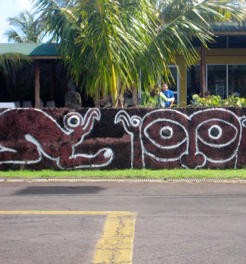
Three Days on the Wild Side
